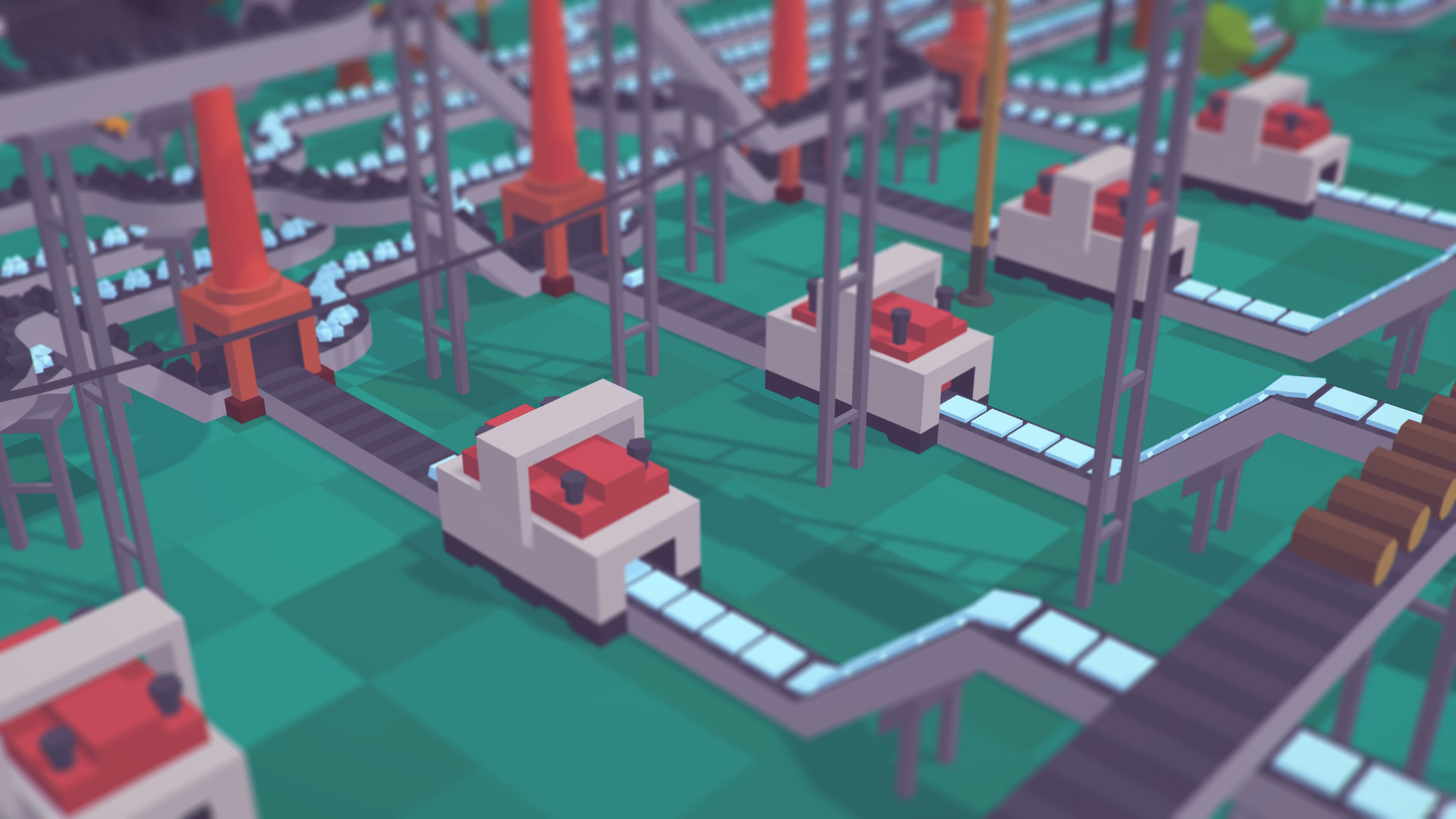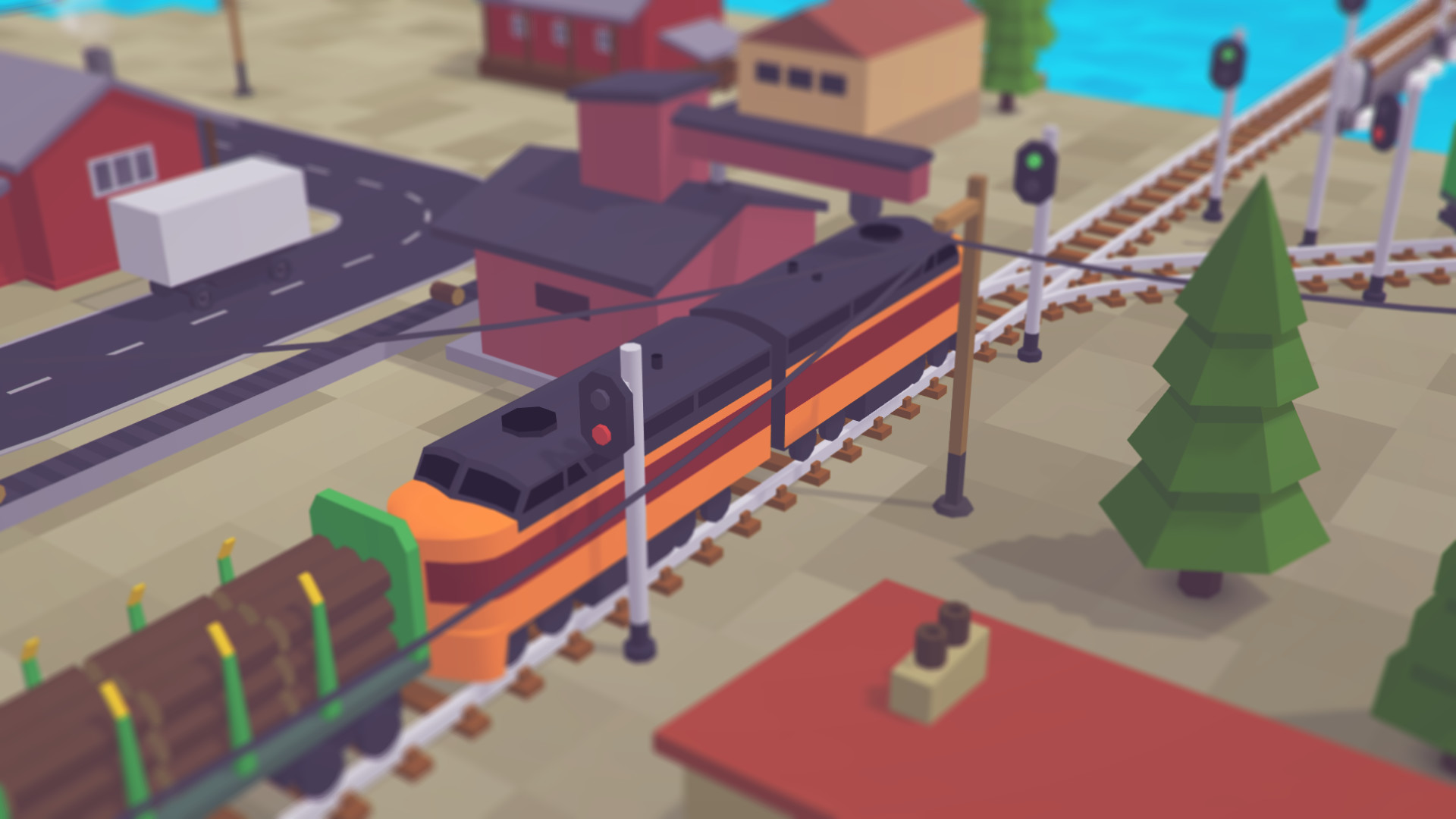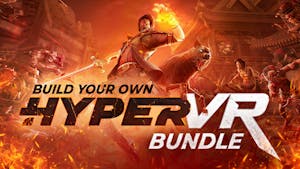Voxel Tycoon - a tycoon strategy game about transportation, factories, and mining in beautiful voxel landscapes.
Inspired by the most notable transport games in history, expanded with all-new features never before seen in the genre.
Plan detailed, sophisticated rail networks with vast modular terminals and flexible scheduling. Free-form bridging and tunneling, along with a full signaling system, allow you complete freedom to build and expand your business.
Renewable resources, like forestry and water, are also subjects of interest.
Don't forget that your factories will need energy to operate, too! This can be supplied by building generating stations and power lines, or simply connecting to local utilities and purchasing electricity.
The world is endless, so you’ll never run out of space. And space isn't just on the surface - you can explore, dig through (or just blow up) every single voxel, all the way down to bedrock.
For the most successful tycoons, we include full-featured terraforming: turn the world into exactly what you want, all according to your perfect plan!
Growth of a city doesn't simply increase the quantity of goods required - higher stages of development will move away from the basics, requiring more complex and expensive products.
Inspired by the most notable transport games in history, expanded with all-new features never before seen in the genre.
Trains and Rail Networks
Rent or buy rail equipment, choosing from dozens of available locomotives and railcars. Couple up consists in any combination, just the way you like, with no limits - provided the locomotives can pull it!Plan detailed, sophisticated rail networks with vast modular terminals and flexible scheduling. Free-form bridging and tunneling, along with a full signaling system, allow you complete freedom to build and expand your business.
Not By Rail Alone
Use trucks and buses to move passengers and cargo short distances. Take commuters around busy city streets, making connections at train stations for long distance travel, or deliver goods by truck from a rail terminal directly to consumers for extra profit.More to Come!
We are committed to adding more features and modes of transport during Early Access, such as ships and aircraft, and infrastructure to accommodate them. Other features will also be added for existing modes, including something never seen before in a tycoon game: fully functional railway shunting yards!Mining and Processing
Automate surface and underground mining with open pits or mine shafts, then process the raw materials using crushers, furnaces, refineries and other machinery.Renewable resources, like forestry and water, are also subjects of interest.
Manage Local Logistics
Complex production chains require complex logistics! Design unique factories of your very own by connecting machinery, buildings and storage facilities with conveyor belts and pipe networks.Don't forget that your factories will need energy to operate, too! This can be supplied by building generating stations and power lines, or simply connecting to local utilities and purchasing electricity.
Research New Technologies
Fund and supply research of new technologies, unlocking new buildings, blueprints and vehicles, or upgrades for existing ones.Infinite World
Explore an unlimited, procedurally-generated world filled with unique biomes and stunning vistas. Prospect for rare resources and opportunities, and find new cities to develop.The world is endless, so you’ll never run out of space. And space isn't just on the surface - you can explore, dig through (or just blow up) every single voxel, all the way down to bedrock.
For the most successful tycoons, we include full-featured terraforming: turn the world into exactly what you want, all according to your perfect plan!
Supply Cities' Needs
Every city has its own needs, which you can fulfill to kick-start growth. The bigger a city gets, the more consumers and passengers move in, meaning more potential profit!Growth of a city doesn't simply increase the quantity of goods required - higher stages of development will move away from the basics, requiring more complex and expensive products.
Passengers are Important, Too!
Don’t just focus all of your efforts on freight - people have destinations to get to as well! Manage passenger flow between cities, and don't forget to treat them with care - different passengers are all heading to different places, and have different comfort preferences.Moddable from Day One
Voxel Tycoon is developed with rich extensibility in mind. A lot of aspects can be modded: from changing existing config files to adding new vehicles and buildings, to writing custom logic using our C# API.Workshop Support
We support Steam Workshop as the easiest way to deliver plenty of community made mods to you.
Wear & Tear Update is out now!
Let's start with the most obvious addition: the new vehicle wear and reliability system. Each vehicle now has a reliability stat that determines how quickly it wears down with use. Early-game vehicles tend to be less reliable, while modern ones become increasingly dependable.

If a vehicle isnt serviced regularly, its performance will begin to drop. This makes proper maintenance not just a good idea, but a critical part of your transport strategy. Unserviced vehicles also wear out faster, amplifying the issue.
Once a vehicle becomes fully worn out, it'll demand more frequent services just to stay operational, leading to increasing maintenance costs and longer periods of reduced performance. If left unchecked, this can trigger traffic jams and cascading delays.

Each vehicle now displays detailed wear information in the UI, making it easier to stay on top of these issues. Since a train can consist of multiple locomotives, each one wears down independently meaning different locomotives in the same train may have varying levels of wear. Wear is also shown in the Fleet Window (based on the most worn-out part of a consist), allowing you to quickly assess each vehicles condition at a glance.
To keep everything running smoothly, you'll need to schedule regular maintenance by sending vehicles to depots at appropriate intervals. Service intervals are configurable per vehicle, so you're in full control over how often your fleet visits the depot.
That said, there might be situations where choosing a longer or even no maintenance interval could make sense. It all depends on your immediate goals and broader strategy. Whether you're squeezing every last mile out of a vehicle before replacement or minimizing downtime in a critical supply chain, there's room for experimentation.
And speaking of depots, you can now add them directly to a vehicles schedule just like regular stations. This gives you full control over when and where maintenance happens, making it a seamless part of your transport flow.

On the visual side, wear comes with a cosmetic touch: smoke emitted from the vehicle darkens as wear builds up, giving a clear visual cue that something's not quite right. In addition, worn-out locomotives and trucks become visibly tilted, further emphasizing their deteriorating condition.

We've also introduced vehicle replacement based on wear levels. You can now set a threshold for when a vehicle should be replaced due to wear. When this setting is enabled, you can also enable self-replacement, effectively allowing vehicles to automatically replace themselves when worn out.

Fleet variety has gotten a major boost. We've added brand-new trucks for each generation and reworked older ones to better match today's standards. Shoutout to @scailman for the amazing help with this overhaul!

Each vehicle has also been rebalanced to offer unique strengths and weaknesses. This means your transport strategy will matter more than ever whether you're prioritizing reliability, speed, or capacity.
Vehicles and buildings are now clearly categorized as "current" or "obsolete" as you progress through research, making it easier to keep track of what's relevant for your tech level.
Higher-tier vehicles are no longer locked behind Tier II depots instead, those depots now come with the perk of lower maintenance costs. This change also resolves a long-standing source of confusion: many players would research Depot II expecting access to new vehicles, only to discover that those vehicles were gated behind separate research. That disconnect caused unnecessary frustration, and we're glad to be putting it behind us.
We've also cleaned up the vehicle scheduling experience by removing confusing options that didn't make sense for waypoints.

Another ongoing effort we'd like to highlight is performance optimization. It's something we never stop working on even if the results aren't always flashy or immediately visible. With this update, we continued the optimization work that began in earlier updates and specifically targeted the Builder Tool window. If you play with lots of mods installed, you should get better performance here: fewer lags, less FPS drops, and reduced memory consumption.
Weve also made a couple of quality-of-life improvements. When placing signals, the regular signal is now selected by default instead of the pre-signal, making construction more intuitive. Additionally, the Settings window now includes a search function just start typing to quickly filter and find the option you need.

We've tackled several stubborn bugs. First up, a rare issue where the UI could become completely unresponsive has been fixed. We also resolved a visual bug affecting heap item storage rendering.
One of the more infamous bugs the so-called "Worm Train" issue caused a pink tint to remain after using the vehicle picker tool. That's gone now.

The Worm Train case.
Trains should also behave better when leaving depots. We fixed a case where they couldn't find their path, and another rare but amusing bug where trains could explode when turning around while still partially inside a depot.

There's something here for modders to enjoy. Most notably, you can now repaint assets directly in the game world using the new Paint Assets tool. To enable it, open Settings while holding Shift, go to the Misc tab, and toggle Asset Paint Tool (you can type Asset to find it). Then reload your save file the tool will appear in the Toolbar under the Other category. After painting, click on the changed mesh in the list above the color picker to save changes to disk or revert them.
Note that enabling this setting introduces a performance overhead that will persist until you reload the world, even if the tool is no longer in use so be sure to disable it once you're done, and reload your save file.

Pro Tip: Hold [i]Alt to pick colors from any other asset in the world.[/i]
We've also added a new Generation property for buildings, cars, and trains, as well as a Reliability property for cars and trains. There's now a new Experimental vehicle engine type too. Storage definitions have been simplified with a new Bounds property that automatically handles Resolution and Keyframes. Auto price calculation now takes both max speed and reliability into account, making for more accurate pricing behavior.
That's it for now! We want to take a moment to say thank you. Thanks a lot for all the thoughtful feedback it really means a lot that people are still thinking about the game, whether you're actively playing or just keeping an eye on things.
The game is being developed slowly, but surely. As some of you rightly guessed, it's a passion project, and we're a very small team doing our best to build something meaningful and long-lasting. We always aimed for a steady, honest approach instead of rushing features.
We totally understand if some of you expected things to be further along by now. Truth is, we wish we could move faster too, but we also don't want to compromise the quality and vision we had from the start.
The Rails and Roads Rework is indeed our next major milestone, and we all agree it's a big one. It's a foundational update that touches core gameplay and will open the door to many long-awaited features and improvements. We're genuinely excited about it, and we think many of you will be too once it lands.
For those of you who joined us recently: what is the Rails and Roads Rework (RRR), exactly? In short, it's a comprehensive overhaul of how railways and road networks are built, managed, and interact with each other. One of the most exciting additions will be proper level crossings something many of you have asked for. It's a huge technical task, but we're building it to support a more flexible, immersive transport system in the long term.
Again, thanks for your patience and continued interest. Whether you have 900+ hours or you're just discovering the game, we really appreciate you being here.
If you'd like to stay in the loop, ask questions, or just hang out with fellow players, feel free to join us over on Discord we'd love to have you.
Happy transporting!


This update brings a brand new layer of challenge to how you manage your transport empire. With the introduction of the wear and reliability system, keeping your fleet in good shape becomes more important than ever. You'll now have to think not just about routes and schedules, but also long-term maintenance and strategic replacements all while staying ahead of potential traffic jams and extra costs. If you want to dive into the full list of changes, you can find the complete changelog here , as usual.
Under the Hood: Wear and Maintenance
Let's start with the most obvious addition: the new vehicle wear and reliability system. Each vehicle now has a reliability stat that determines how quickly it wears down with use. Early-game vehicles tend to be less reliable, while modern ones become increasingly dependable.

If a vehicle isnt serviced regularly, its performance will begin to drop. This makes proper maintenance not just a good idea, but a critical part of your transport strategy. Unserviced vehicles also wear out faster, amplifying the issue.
Once a vehicle becomes fully worn out, it'll demand more frequent services just to stay operational, leading to increasing maintenance costs and longer periods of reduced performance. If left unchecked, this can trigger traffic jams and cascading delays.

Each vehicle now displays detailed wear information in the UI, making it easier to stay on top of these issues. Since a train can consist of multiple locomotives, each one wears down independently meaning different locomotives in the same train may have varying levels of wear. Wear is also shown in the Fleet Window (based on the most worn-out part of a consist), allowing you to quickly assess each vehicles condition at a glance.
To keep everything running smoothly, you'll need to schedule regular maintenance by sending vehicles to depots at appropriate intervals. Service intervals are configurable per vehicle, so you're in full control over how often your fleet visits the depot.
That said, there might be situations where choosing a longer or even no maintenance interval could make sense. It all depends on your immediate goals and broader strategy. Whether you're squeezing every last mile out of a vehicle before replacement or minimizing downtime in a critical supply chain, there's room for experimentation.
And speaking of depots, you can now add them directly to a vehicles schedule just like regular stations. This gives you full control over when and where maintenance happens, making it a seamless part of your transport flow.

On the visual side, wear comes with a cosmetic touch: smoke emitted from the vehicle darkens as wear builds up, giving a clear visual cue that something's not quite right. In addition, worn-out locomotives and trucks become visibly tilted, further emphasizing their deteriorating condition.

We've also introduced vehicle replacement based on wear levels. You can now set a threshold for when a vehicle should be replaced due to wear. When this setting is enabled, you can also enable self-replacement, effectively allowing vehicles to automatically replace themselves when worn out.

A New Generation of Trucks
Fleet variety has gotten a major boost. We've added brand-new trucks for each generation and reworked older ones to better match today's standards. Shoutout to @scailman for the amazing help with this overhaul!

Each vehicle has also been rebalanced to offer unique strengths and weaknesses. This means your transport strategy will matter more than ever whether you're prioritizing reliability, speed, or capacity.
Smarter, Smoother, and More Intuitive
Vehicles and buildings are now clearly categorized as "current" or "obsolete" as you progress through research, making it easier to keep track of what's relevant for your tech level.
Higher-tier vehicles are no longer locked behind Tier II depots instead, those depots now come with the perk of lower maintenance costs. This change also resolves a long-standing source of confusion: many players would research Depot II expecting access to new vehicles, only to discover that those vehicles were gated behind separate research. That disconnect caused unnecessary frustration, and we're glad to be putting it behind us.
We've also cleaned up the vehicle scheduling experience by removing confusing options that didn't make sense for waypoints.

Another ongoing effort we'd like to highlight is performance optimization. It's something we never stop working on even if the results aren't always flashy or immediately visible. With this update, we continued the optimization work that began in earlier updates and specifically targeted the Builder Tool window. If you play with lots of mods installed, you should get better performance here: fewer lags, less FPS drops, and reduced memory consumption.
Weve also made a couple of quality-of-life improvements. When placing signals, the regular signal is now selected by default instead of the pre-signal, making construction more intuitive. Additionally, the Settings window now includes a search function just start typing to quickly filter and find the option you need.

Squashed Bugs and Polished Gears
We've tackled several stubborn bugs. First up, a rare issue where the UI could become completely unresponsive has been fixed. We also resolved a visual bug affecting heap item storage rendering.
One of the more infamous bugs the so-called "Worm Train" issue caused a pink tint to remain after using the vehicle picker tool. That's gone now.

The Worm Train case.
Trains should also behave better when leaving depots. We fixed a case where they couldn't find their path, and another rare but amusing bug where trains could explode when turning around while still partially inside a depot.

For the Modding Wizards
There's something here for modders to enjoy. Most notably, you can now repaint assets directly in the game world using the new Paint Assets tool. To enable it, open Settings while holding Shift, go to the Misc tab, and toggle Asset Paint Tool (you can type Asset to find it). Then reload your save file the tool will appear in the Toolbar under the Other category. After painting, click on the changed mesh in the list above the color picker to save changes to disk or revert them.
Note that enabling this setting introduces a performance overhead that will persist until you reload the world, even if the tool is no longer in use so be sure to disable it once you're done, and reload your save file.

Pro Tip: Hold [i]Alt to pick colors from any other asset in the world.[/i]
We've also added a new Generation property for buildings, cars, and trains, as well as a Reliability property for cars and trains. There's now a new Experimental vehicle engine type too. Storage definitions have been simplified with a new Bounds property that automatically handles Resolution and Keyframes. Auto price calculation now takes both max speed and reliability into account, making for more accurate pricing behavior.
Thank you
That's it for now! We want to take a moment to say thank you. Thanks a lot for all the thoughtful feedback it really means a lot that people are still thinking about the game, whether you're actively playing or just keeping an eye on things.
The game is being developed slowly, but surely. As some of you rightly guessed, it's a passion project, and we're a very small team doing our best to build something meaningful and long-lasting. We always aimed for a steady, honest approach instead of rushing features.
We totally understand if some of you expected things to be further along by now. Truth is, we wish we could move faster too, but we also don't want to compromise the quality and vision we had from the start.
The Rails and Roads Rework is indeed our next major milestone, and we all agree it's a big one. It's a foundational update that touches core gameplay and will open the door to many long-awaited features and improvements. We're genuinely excited about it, and we think many of you will be too once it lands.
For those of you who joined us recently: what is the Rails and Roads Rework (RRR), exactly? In short, it's a comprehensive overhaul of how railways and road networks are built, managed, and interact with each other. One of the most exciting additions will be proper level crossings something many of you have asked for. It's a huge technical task, but we're building it to support a more flexible, immersive transport system in the long term.
Again, thanks for your patience and continued interest. Whether you have 900+ hours or you're just discovering the game, we really appreciate you being here.
If you'd like to stay in the loop, ask questions, or just hang out with fellow players, feel free to join us over on Discord we'd love to have you.
Happy transporting!

[ 2025-04-06 01:34:19 CET ] [Original Post]
Minimum Setup
- OS: Ubuntu 16.04
- Processor: Dual Core 2GHzMemory: 4 GB RAM
- Memory: 4 GB RAM
- Graphics: 512MB VRAM
- Storage: 500 MB available space
Recommended Setup
- OS: Ubuntu 18.04
- Processor: Quad Core 3GHzMemory: 8 GB RAM
- Graphics: 2GB VRAM
- Storage: 500 MB available space
GAMEBILLET
[ 6425 ]
GAMERSGATE
[ 3675 ]
MacGamestore
[ 2899 ]
FANATICAL BUNDLES
HUMBLE BUNDLES
by buying games/dlcs from affiliate links you are supporting tuxDB
















































